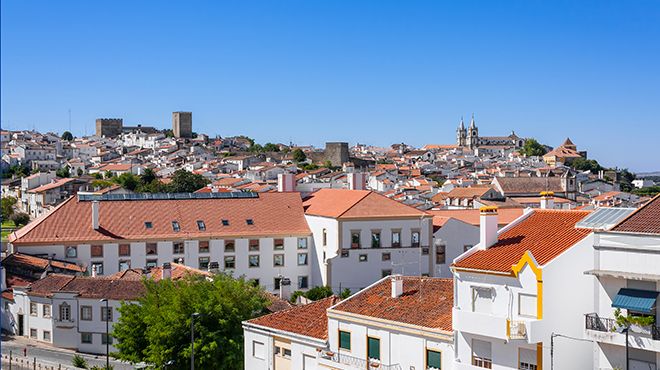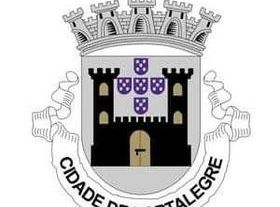Portalegre

Portalegre
Towns and Villages
Located in the São Mamede Hills close to the border with Spain, Portalegre retained strategic importance for national defence throughout the Middle Ages. King Afonso III (1248-79) granted the settlement its first royal charter before handing it over to his bastard son Afonso Sanches. This move was far from popular with Dinis (1279-1325), his brother and heir to the throne. In 1299, Dinis, already king, returned Portalegre to the status of royal possession and ordered the rebuilding of the Castle.
Also in medieval times, the Franciscan order established a presence in Portalegre most notably in the Convents of São Francisco (St. Francis) and Santa Clara (Saint Claire).
In the early 16th century, after the founding of the Misericórdia de Portalegre (a nationwide charity institution), the Bishop of Guarda, Jorge de Melo ordered the building of the Convent Cisterciense de São Bernardo (Cistercians of St. Bernard). Already an important administrative and economic centre, it became a city under king João III who further established the Diocese of Portalegre and ordered the building of the Cathedral.
This decision was further consolidated by decisions to go ahead with the Episcopal Palace and the Diocese Seminary, now the Municipal Museum.
The 17th and 18th centuries left a strong Barroque character to the city with monuments such as the Church of São Lourenço (St Laurence) and the impressive Amarelo (Yellow), Falcões (Falcons) and Achioli palaces. These are praiseworthy examples, preserving the coats of arms of the families who built and richly decorated them in forged iron, a unique regional feature.
After the prohibition of religious orders in 1834, and with the beginning of the industrial revolution, the city turned to renewal and converted some of the former convents and palaces.
Examples of this are the Convent of Santo Agostinho (St. Augustine) becoming the headquarters of the National Republican Guard, the Convent of São Bernardo and the Jesuit São Sebastião (St. Sebastian) convent taken over by the Manufactura de Tapeçarias de Portalegre (Carpet Manufacturing) or the Castel-Branco Palace that recently became the Tapeçaria de Portalegre Guy Fino (Carpet) Museum detailing the contribution made by the textile industry to the city´s development.
In Portalegre, a city easily manageable on foot, there is also the Portuguese poet José Régio Museum House. On the outskirts, attention goes to the views from the Church of Nossa Senhora da Penha (Our Lady of Suffering) and the Church of Bonfim, Located on the road heading to Marvão and Castelo de Vide, both are well worth a closer look.
Also in medieval times, the Franciscan order established a presence in Portalegre most notably in the Convents of São Francisco (St. Francis) and Santa Clara (Saint Claire).
In the early 16th century, after the founding of the Misericórdia de Portalegre (a nationwide charity institution), the Bishop of Guarda, Jorge de Melo ordered the building of the Convent Cisterciense de São Bernardo (Cistercians of St. Bernard). Already an important administrative and economic centre, it became a city under king João III who further established the Diocese of Portalegre and ordered the building of the Cathedral.
This decision was further consolidated by decisions to go ahead with the Episcopal Palace and the Diocese Seminary, now the Municipal Museum.
The 17th and 18th centuries left a strong Barroque character to the city with monuments such as the Church of São Lourenço (St Laurence) and the impressive Amarelo (Yellow), Falcões (Falcons) and Achioli palaces. These are praiseworthy examples, preserving the coats of arms of the families who built and richly decorated them in forged iron, a unique regional feature.
After the prohibition of religious orders in 1834, and with the beginning of the industrial revolution, the city turned to renewal and converted some of the former convents and palaces.
Examples of this are the Convent of Santo Agostinho (St. Augustine) becoming the headquarters of the National Republican Guard, the Convent of São Bernardo and the Jesuit São Sebastião (St. Sebastian) convent taken over by the Manufactura de Tapeçarias de Portalegre (Carpet Manufacturing) or the Castel-Branco Palace that recently became the Tapeçaria de Portalegre Guy Fino (Carpet) Museum detailing the contribution made by the textile industry to the city´s development.
In Portalegre, a city easily manageable on foot, there is also the Portuguese poet José Régio Museum House. On the outskirts, attention goes to the views from the Church of Nossa Senhora da Penha (Our Lady of Suffering) and the Church of Bonfim, Located on the road heading to Marvão and Castelo de Vide, both are well worth a closer look.




 Explore
Explore 
 Remember and Share
Remember and Share 


